Driving Virginia’s Blue Ridge Parkway in Fall – 2024 Guide
Fall 2024 Guide to Driving the Virginia Section of the Blue Ridge Parkway
There are many special places you can visit in fall—all over the world. If, however, you’re looking for a destination in the United States, and more specifically Virginia, you should definitely consider driving the Blue Ridge Parkway in fall.
Although this famous mountain road is wonderful basically all year round, it’s at its most spectacular in October.
In this Blue Ridge Parkway guide, I talk about the best things to see on the Blue Ridge Parkway, my favorite Blue Ridge Parkway overlooks, and I share some of my best Blue Ridge Parkway images.
This Virginia Blue Ridge Parkway in fall travel guide contains affiliate links. You can read more about our Terms of Use / Disclosure here.
What Is the Blue Ridge Parkway?
The Blue Ridge Parkway winds its way across the crest of the southern Appalachian Mountains, connecting Shenandoah National Park in Virginia and Great Smoky Mountains National Park in North Carolina and Tennessee.
Construction on the road began in 1935, but its entire 469 miles (755 kilometers) weren’t finished until as recently as 1987.
The concept of a scenic, recreational mountain road in the Appalachian Mountains had been planned and surveyed in 1909. However, it took until the 1930s before the plans were actually put in motion.
There were two main reasons to create this road in that particular period of time—the increasing popularity of car travel in the United States and the creation of public service jobs after the Great Depression.

Nowadays, the Blue Ridge Parkway is one of the United States’ greatest mountain roads and, with no fewer than 16 million annual visitors, one of the most visited units in the National Park Service system.
It’s a road offering travelers the chance to explore the Blue Ridge Mountains uninterruptedly and to their fullest extent. There are no traffic lights on its entire 469-mile length, nor is there any advertising.
The Blue Ridge Parkway is all about enjoying some of the nation’s greatest mountain scenery, doing some scenic hiking and visiting historic sites.
I recommend driving the Blue Ridge Parkway in fall. The landscapes are beautifully bright, the waterfalls even more scenic and the crisp mountain mornings invigorating.
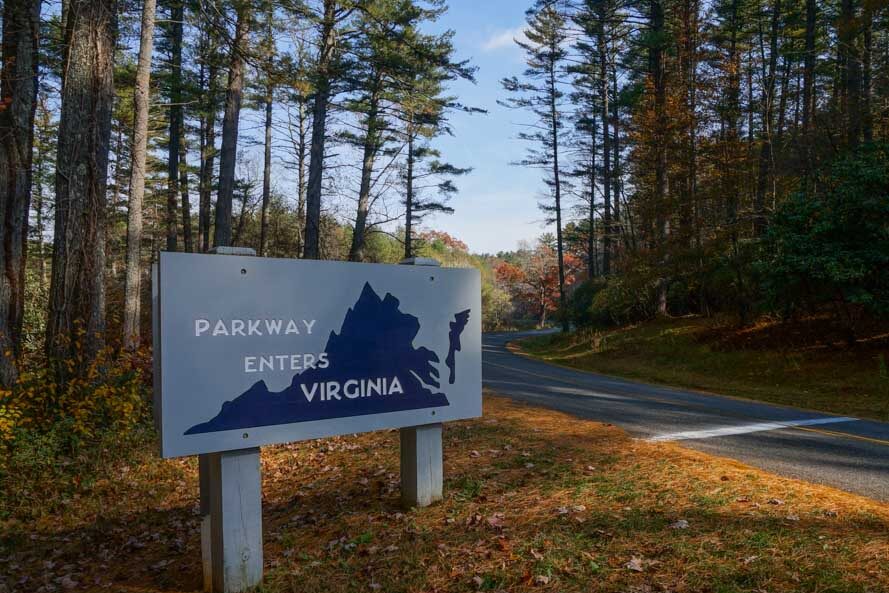
Highlights on the Blue Ridge Parkway, Virginia
The Virginia section of the Blue Ridge Parkway is 217 miles (349 kilometers) long. It runs from Rockfish Gap at the entrance of Shenandoah National Park southward to the North Carolina border.
Between these two points, there are several major attractions, which should be the focal points in your itinerary.
They are the following. (MP stands for milepost, which indicates the distance from Rockfish Gap, the Parkway’s northern terminus.) Keep in mind that these highlights do not include any overlooks. The best of those are listed later on in this blog post.
Humpback Rock (MP 5 to 9.3)
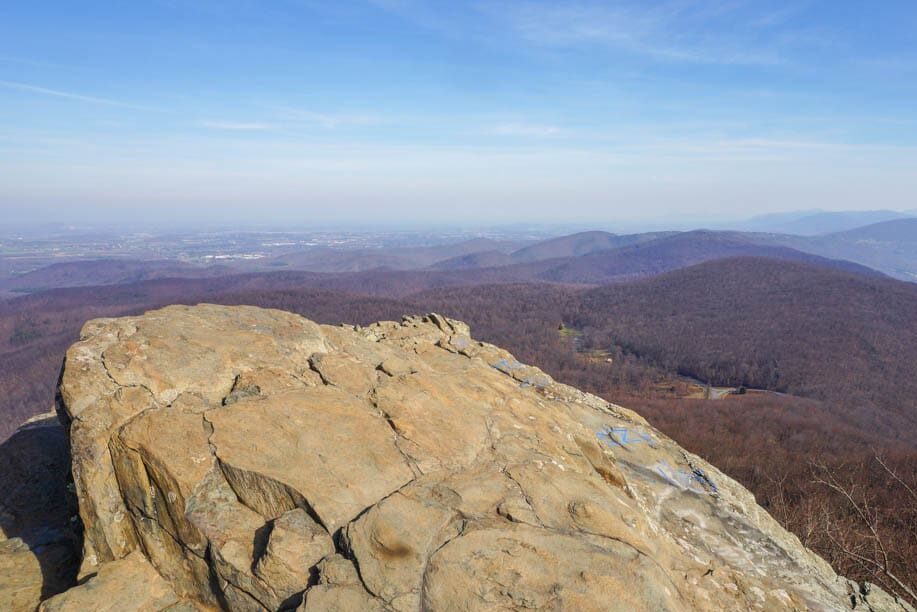
Humpback Rock is the first major attraction on the Blue Ridge Parkway. It has a lot to offer, from a basic visitor center to an outdoor exhibit of old Appalachian farm buildings and a 1-mile (1.6-kilometer) hiking trail to the area’s namesake Humpback Rock.
This rock’s humped shape makes for fun rock scrambling and provides rewarding views.
Otter Creek and the James River (MP 58 to 63.8)
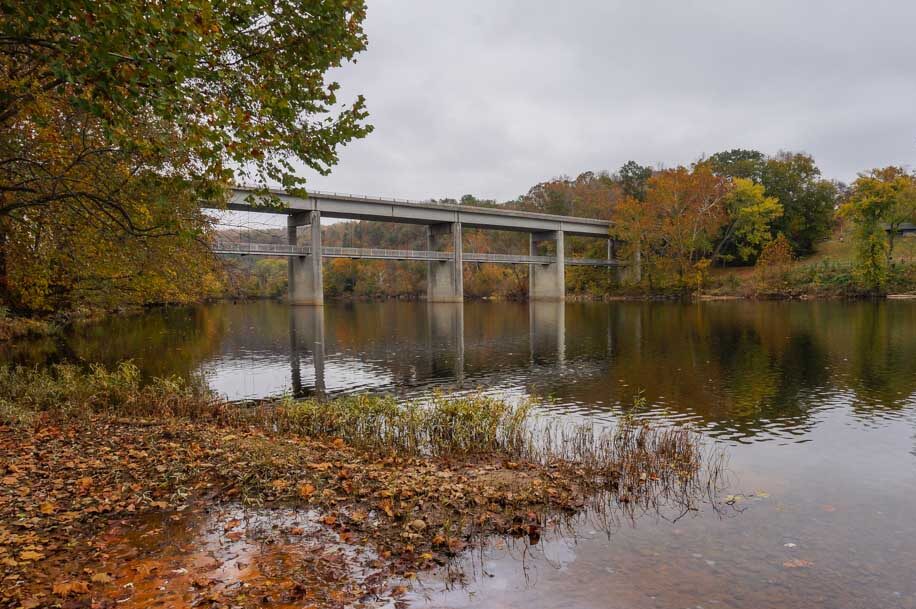
Otter Creek tumbles down the Blue Ridge Mountains toward the James River. It passes through Otter Lake, which offers peaceful fishing and hiking opportunities. There’s a scenic waterfall at the southern end of Otter Lake as well.
The James River, a short distance to the south of Otter Lake, is one of the major stopping points on the Virginia section of the Blue Ridge Parkway. It has a good visitor center and a grassy picnic area.
The major highlights here are the footbridge across the James River and the restored canal locks of the historic Kanawha Canal.
Peaks of Otter (MP 84 to 87)
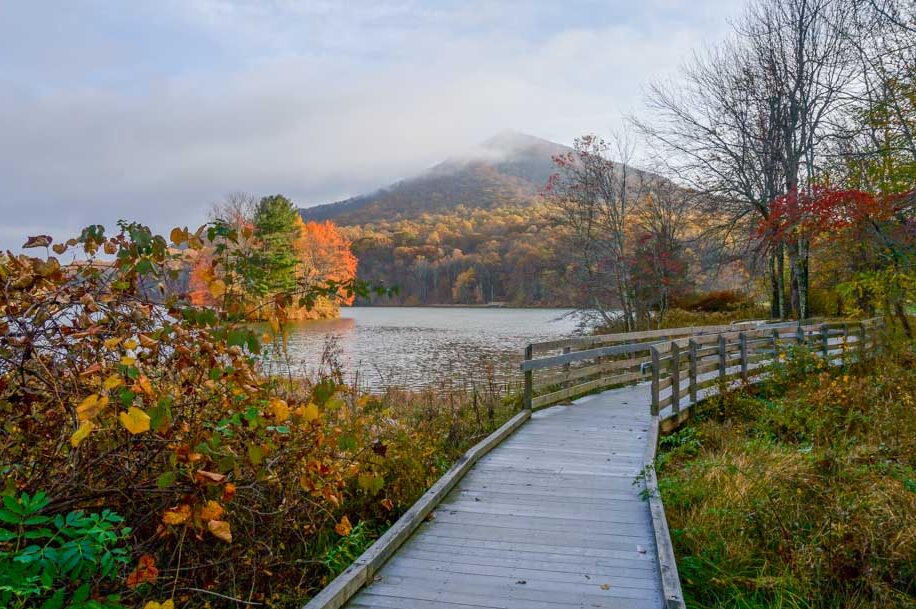
Without question one of the star attractions on the Blue Ridge Parkway in Virginia, Peaks of Otter has been a popular tourist destination since as early as the early 1800s (Thomas Jefferson’s time, in other words). There’s a lot to see and do here.
First of all, the Peaks of Otter Lodge is the only year-round accommodation on Virginia’s Blue Ridge Parkway.
Set on the shore of man-made Abbott Lake, its setting dominated by the three Peaks of Otter, this lodge couldn’t possibly be any more beautiful.
Attractions include the historic Johnson Farm and the Nature Center. Additionally, this area offers some of the best hiking on this section of the Parkway.
There are several hiking trails to choose from. I’d suggest the Fallingwater Cascades Trail and the Sharp Top Trail (see below).
Smart View (MP 154.5)
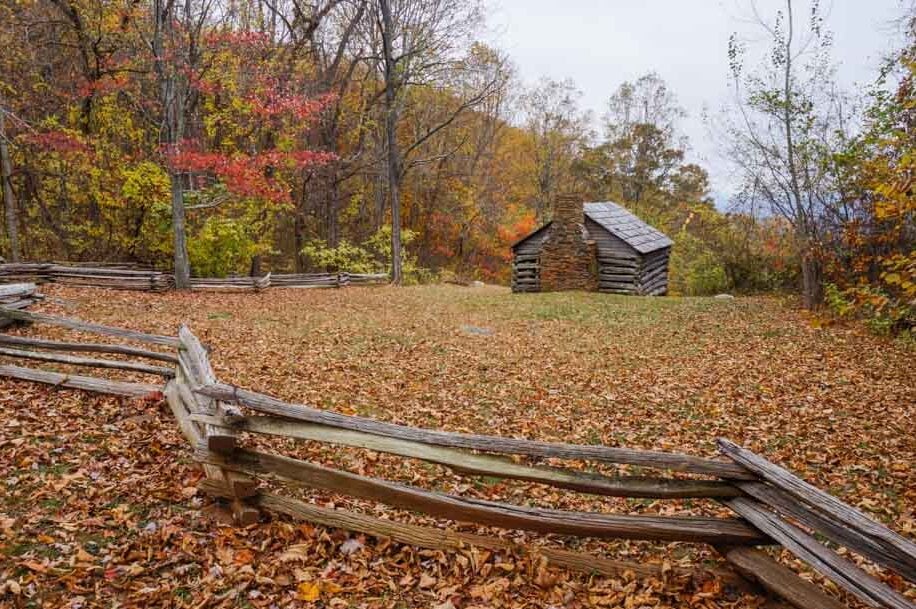
The historic cabin at the Smart View Overlook is worthy of a brief stop on your way to Mabry Mill. Built in the 1890s, this so-called Trail Cabin shows the kind of basic dwellings people used to live in in the Blue Ridge Mountains.
Mabry Mill (MP 176.1)

Mabry Mill is the most photographed spot on the entire Blue Ridge Parkway. It’s easy to see why. Set on the shore of a small pond, this historic watermill is exceptionally picturesque.
Definitely snap a photo yourself here, but also take your time to explore the area.
There is an interesting self-guided walking path that leads you through the collection of buildings once owned by E.B. Mabry, including his blacksmith shop, gristmill and sawmill.
Puckett Cabin (MP 189.9)
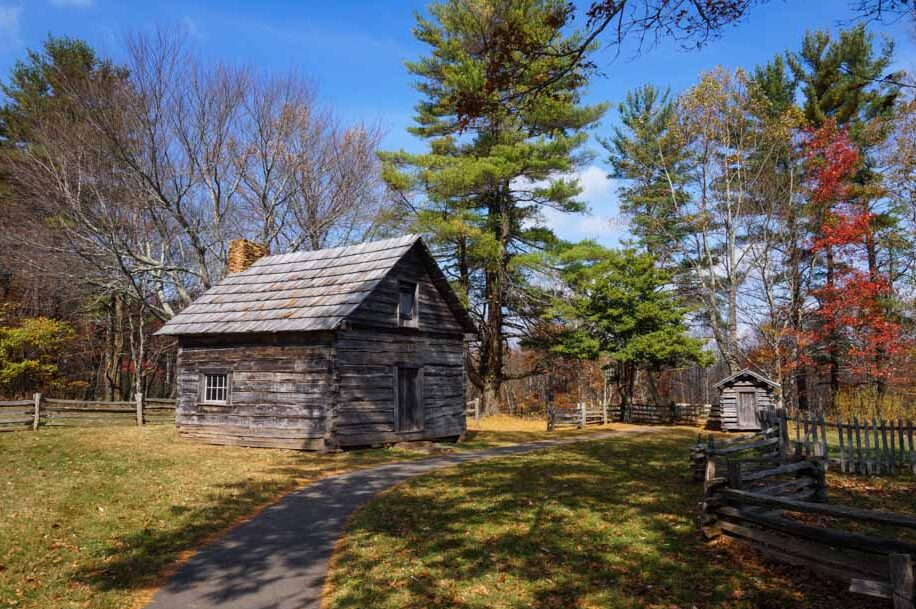
This is the spot where “Aunt” Orelena Hawks Puckett lived during the last part of her 102-year-long life. She was older than 50 when she began what would become a decades-long career as a midwife.
Delivering an astonishing 1,000+ babies, she assisted at her latest birth in 1939, the year she passed away. Her skills are proven by the fact that she never lost a child or mother through her own fault.
Ironically and very sadly, none of her own 24 children survived beyond infancy.
Blue Ridge Music Center (MP 213)
The last highlight before the Parkway enters North Carolina, the Blue Ridge Music Center exhibits the history of Appalachian music.
It includes a visitor center, an outdoor amphitheater, hiking trails and a museum. Definitely worth a stop, but if you’re driving the Blue Ridge Parkway in fall, make sure to pre-check the opening times.
The Center was closed when I was there on a Monday in late-October.
Where to Stay on the Blue Ridge Parkway, Virginia
There are campsites at various spots along the Parkway—at Otter Creek, Peaks of Otter, Roanoke Mountain and Rocky Knob—but they’re only open seasonally. If you’re hitting the road in late fall, you’ll want/need to stay at a lodge.
I highly recommend the Peaks of Otter Lodge.
Located at MP 84.4, this lodge is a convenient stopping point when driving the Blue Ridge Parkway in fall.
Set on the shore of pretty Abbott Lake and surrounded by three mountain peaks, its setting is absolutely beautiful.
One of Virginia’s most picturesque natural attractions, this is the perfect base for hikes to Sharp Top and Flat Top Mountain and Harkening Hill, the three summits that make up the Peaks of Otter.
Other highlights include the historic Johnson Farm, the Nature Center and dinners at the lodge overlooking the lake.
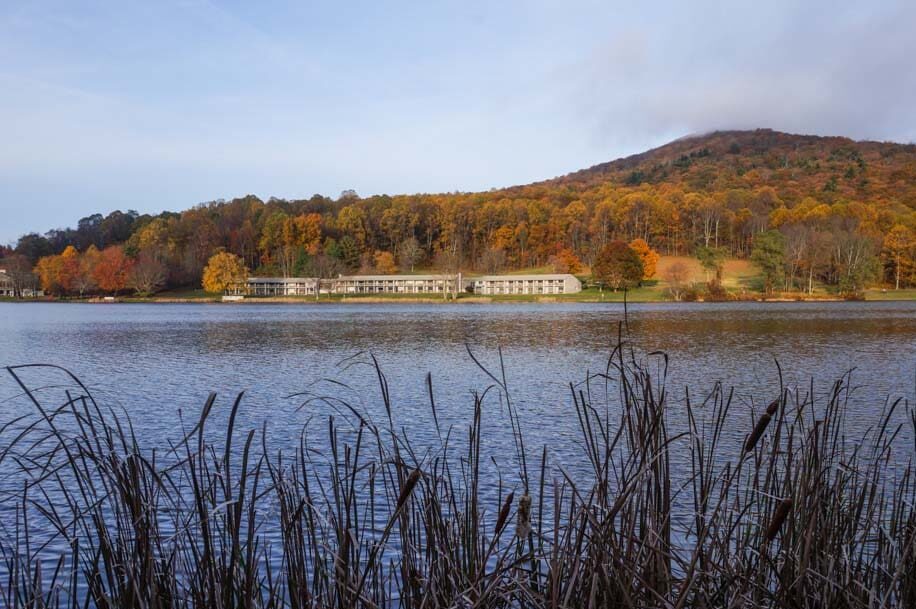
Recommended Hikes on the Blue Ridge Parkway
While the Blue Ridge Parkway is mainly about exploring the mountains by car, there are plenty of opportunities to get out and stretch your legs.
The Appalachian Trail is accessible from a few points and there are several other great hiking trails as well. Depending on your fitness level, you should be able to find a hike that suits you. From leg-stretchers to strenuous mountain climbs, there’s everything.
If you’re looking to do some hiking when driving the Blue Ridge Parkway in fall—and you absolutely should—consider these five suggested hiking trails.
Humpback Rocks Trail (MP 5)

This out-and-back hike is 1 mile (1.6 kilometers) long and starts across the road from the Humpback Rocks Visitor Center.
There are several trails in the area, including the Appalachian Trail, but this is the most popular, and arguably the best, one.
It leads to the huge rocky outcrop that is Humpback Rocks, from the top of which you have spectacular panoramic views of the mountains and Shenandoah Valley.
Otter Lake Loop Trail (MP 63)
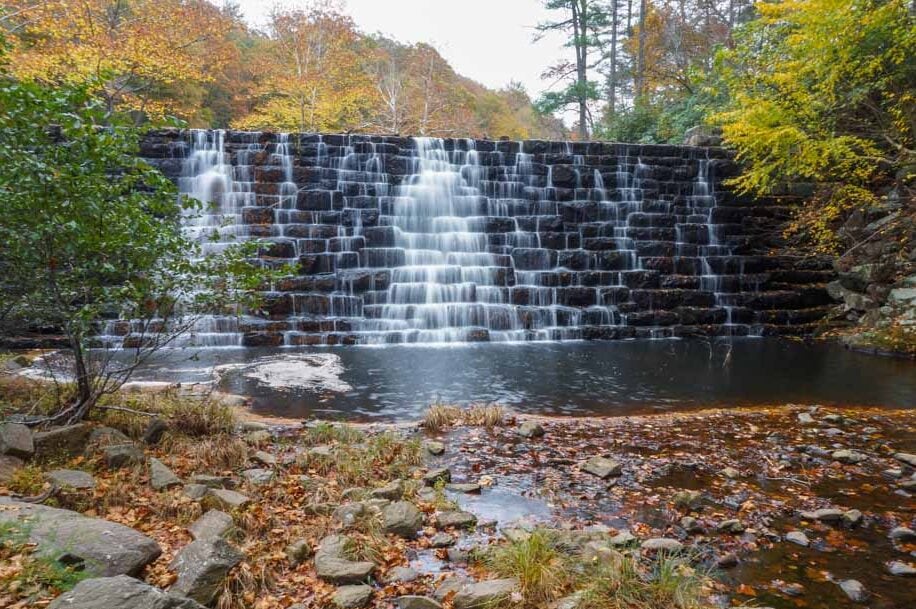
Looping around Otter Lake, the 0.9-mile (1.4-kilometer) Otter Lake Loop Trail is a pleasant leg-stretcher offering beautiful views of little Otter Lake.
This is a good place to spot wildlife as well. Keep your eyes peeled for beavers and deer.
Fallingwater Cascades Trail (MP 83.4)

Its trailhead located less than a mile from the Peaks of Otter Lodge, the Fallingwater Cascades Trail is a great little hike. It’s 1.6 miles (2.6 kilometers) long and loops past Fallingwater Cascades.
This trail is particularly scenic on a cloudy, even foggy, fall morning. One of my favorite short hikes on the Blue Ridge Parkway in Virginia.
Sharp Top Trail (MP 86)
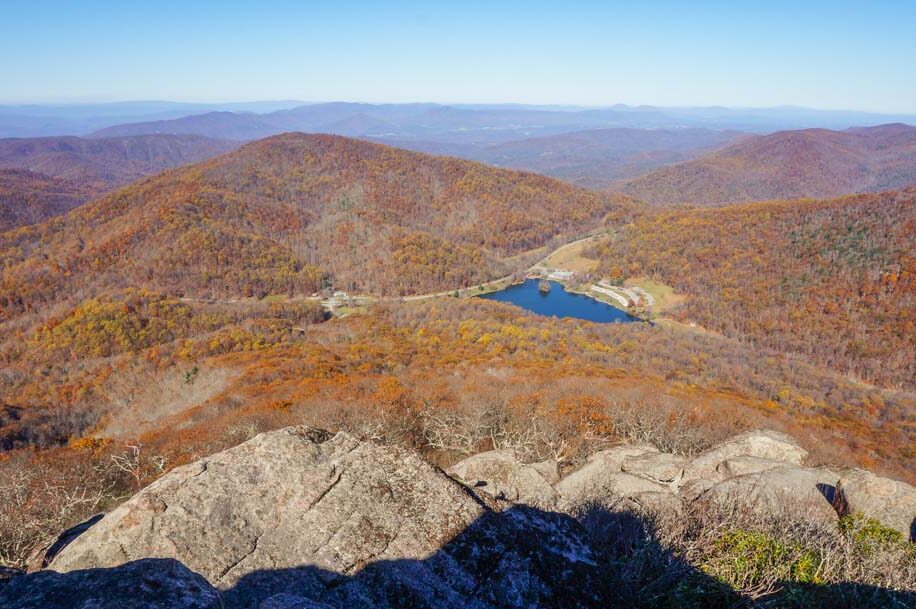
One of the absolute best hikes on Virginia’s Blue Ridge Parkway, the Sharp Top Trail leads from the parking lot across from the Peaks of Otter Visitor Center to the summit of Sharp Top Mountain.
This 1.5-mile (2.4-kilometer) out-and-back trail is moderate for most of its length. Only the last 0.2 miles (300 meters) are very strenuous, climbing a series of stone stairways.
The trail runs through beautiful woods and ends with phenomenal 360-degree views from Sharp Top, which is one of the best summits I’ve ever been on.
Rock Castle Gorge Trail (MP 169)
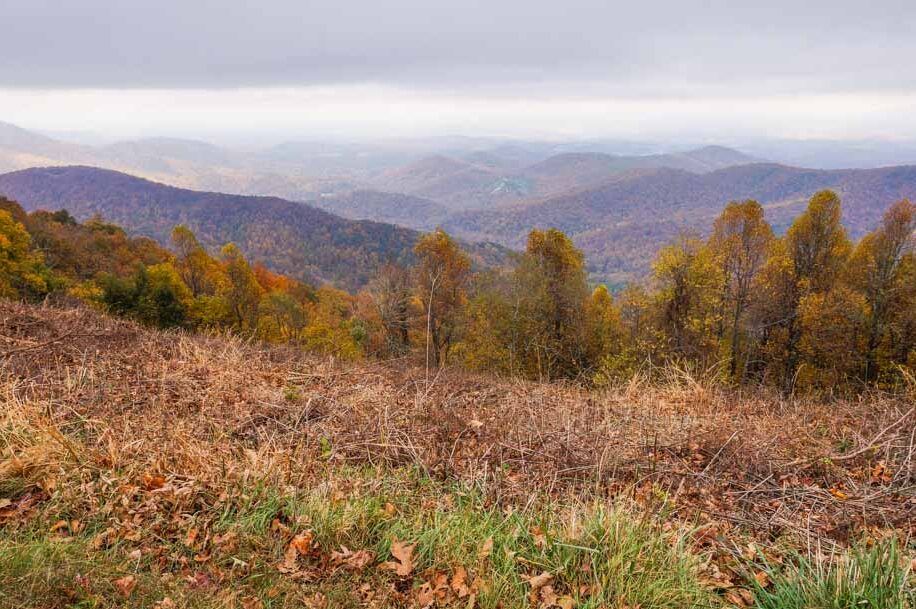
Possibly the most difficult trail on the entire Virginia section of the Blue Ridge Parkway, the Rock Castle Gorge Trail is 10.8 miles (17.4 kilometers) long.
This loop trail can be accessed at a few different overlooks and parking areas near the Rocky Knob Visitor Center.
Leading down from the crest of the Blue Ridge through a forest of hickories, maples, tulip trees, magnolias and oaks, the trail hits its lowest point in scenic Rock Castle Gorge. It follows the gorge for a couple of miles before ascending back to the ridge.
My Favorite Blue Ridge Parkway Overlooks in Virginia
There are countless Blue Ridge Parkway overlooks in Virginia, but some of them are much better than others. It’s no secret that it’s been a struggle to keep things going financially (if you want, you can help out here).
Sometimes, it shows, particularly when it comes to the overlooks. Some overlooks aren’t overlooks at all anymore and offer a view of nothing more than a wall of trees. Others, however, are still absolutely spectacular.
The following are my six favorite overlooks on the Blue Ridge Parkway in Virginia. There’s no need to explain anything when it comes to overlooks. Simply showing the overlook itself should suffice!
Raven’s Roost (MP 10.7)
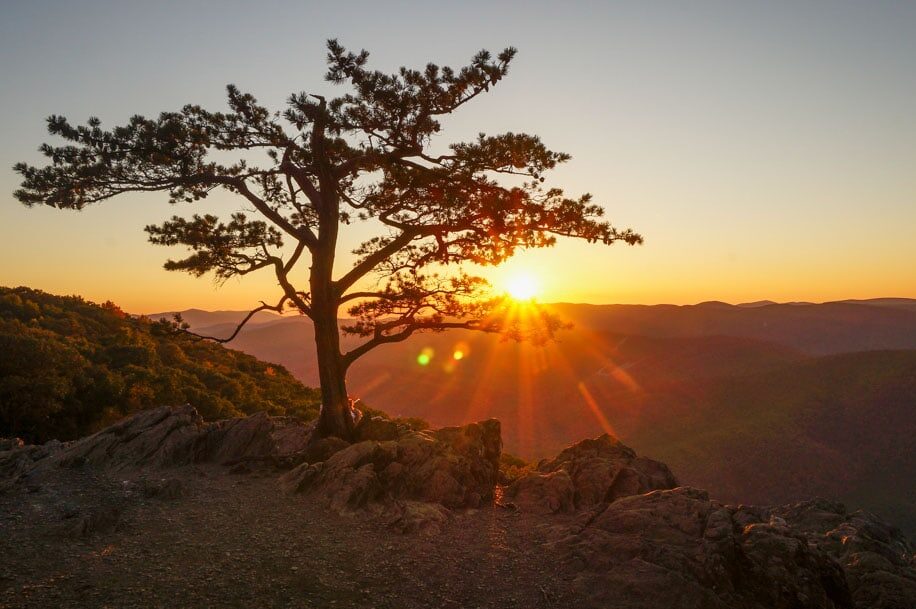
20-Minute Cliff (MP 19)
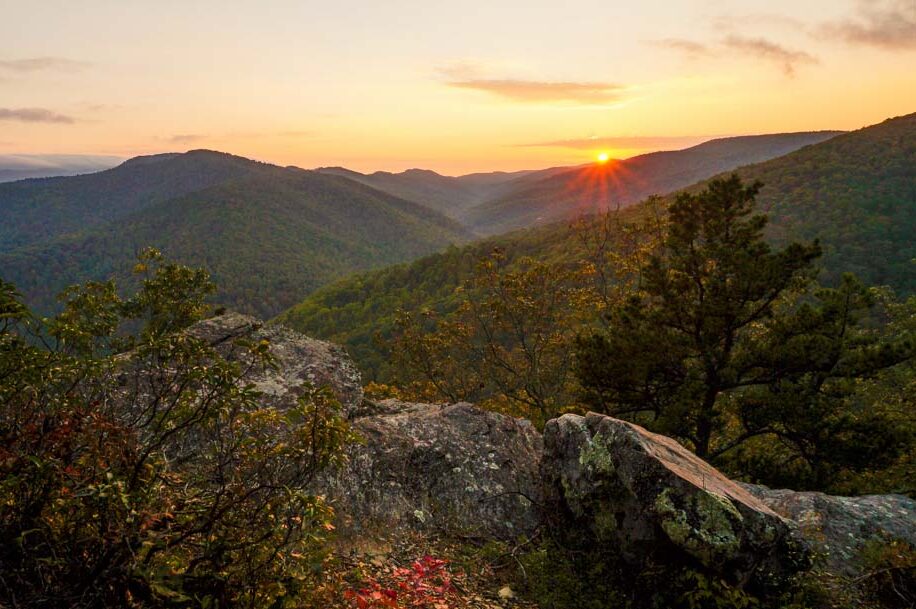
Pine Tree (MP 95.2)
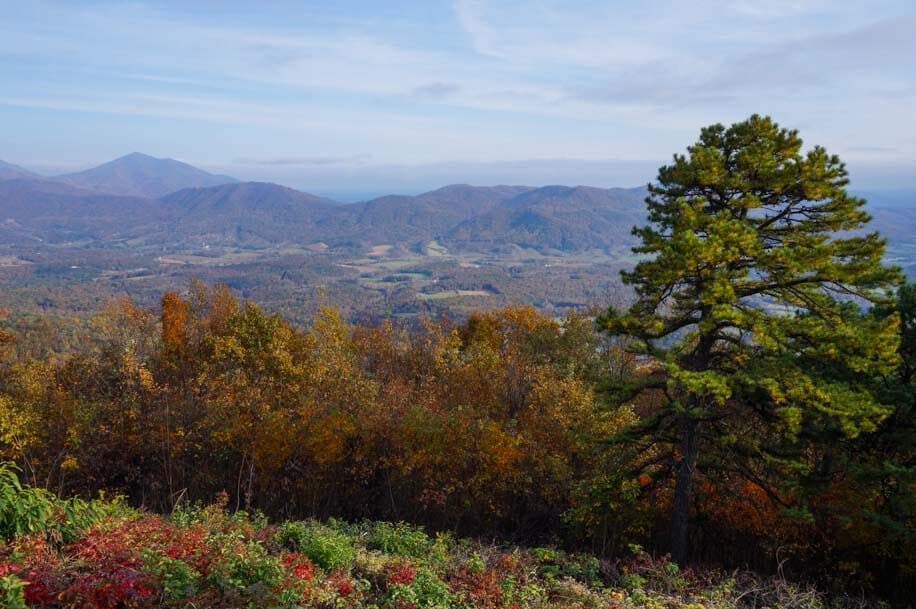
Roanoke Mountain (MP 120.4)
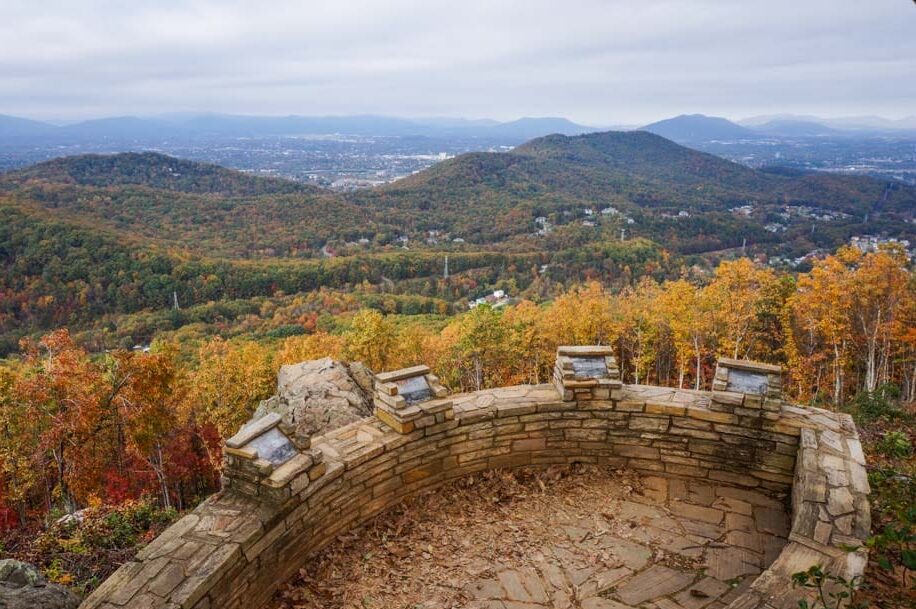
Rocky Knob (MP 167)
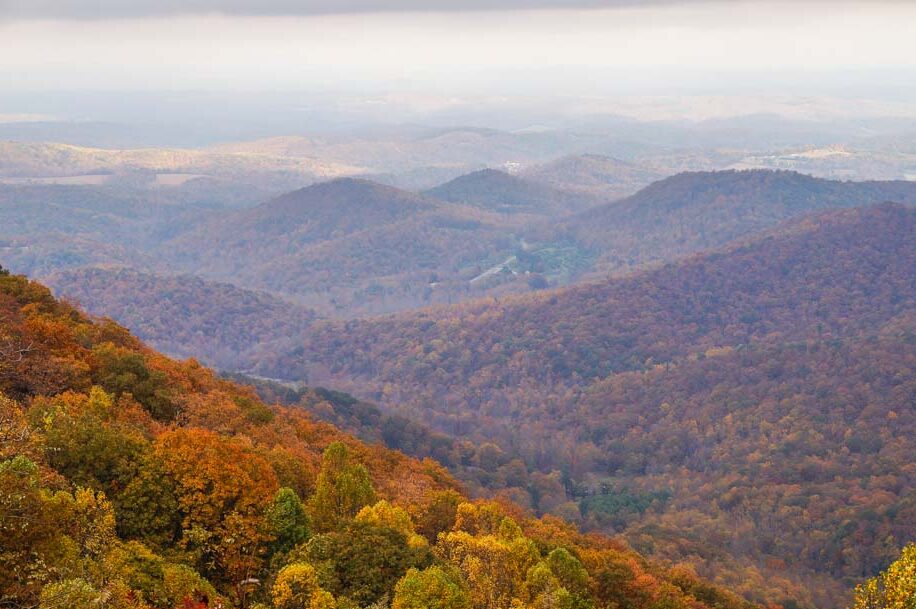
Groundhog Mountain (MP 188.8)
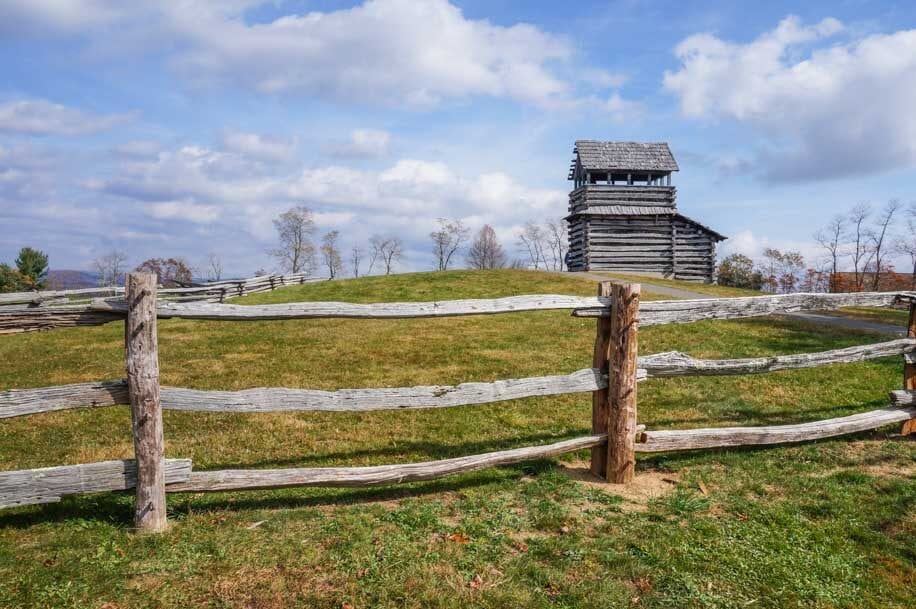
Virginia Blue Ridge Parkway Attractions Overview
Here’s a brief summary of what you can expect when driving the Blue Ridge Parkway in fall.
Use this list—these are my favorite spots on the Parkway—as a guide to put together your own trip.
- Humpback Rocks (MP 5 to 9.3) – Hiking, historic exhibit, visitor center, picnic grounds
- Raven’s Roost Overlook (MP 10.7) – Beautiful views of the Shenandoah Valley and Torry Mountain
- 20-Minute Cliff Overlook (MP 19) – Fine views of a deep mountain valley
- Otter Creek and the James River (MP 58 to 63.8) – Lowest point on the entire Blue Ridge Parkway, hiking, historic exhibits, visitor center, footbridge across James River, picnic grounds
- Peaks of Otter (MP 84 to 87) – Lodging, hiking, historic farm, nature center
- Pine Tree Overlook (MP 95.2) – Spectacular Blue Ridge mountain and valley views
- Roanoke Mountain (MP 120.4) – Steep mountain detour with fantastic views of Roanoke, Virginia
- Smart View (MP 154.5) – 19th-century trail cabin
- Rocky Knob (MP 167) – Hiking trails and overlooks
- Mabry Mill (MP 176.1) – Most photographed spot on the Blue Ridge Parkway in Virginia, historic exhibits
- Groundhog Mountain Overlook (MP 188.8) – Observation tower, picnic grounds, fence exhibit
- Puckett Cabin (MP 189.9) – Historic cabin
- Blue Ridge Music Center (MP 213) – Museum, visitor center, hiking, outdoor amphitheater, music performances

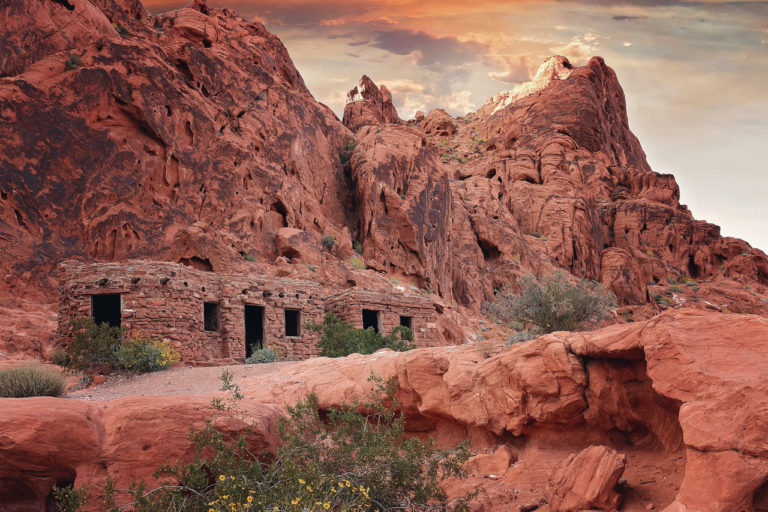





So, I just watched the leaves changing colors this past weekend on the parkway. When I lived in Charlottesville, I visited the parkway often- it was close enough that a 2 hour loop in the evening was the perfect end to a busy day.
Now, I live in Alexandria, which requires two hours just to get to and from the parkway- so i visit less frequently. But, the views are something not to be missed.
I love Shenandoah! I’ve driven it twice. Your photos are spectacular!
Thanks, Stephanie! I still have to drive the North Carolina section, but I’ve heard it’s equally as stunning. Next year!